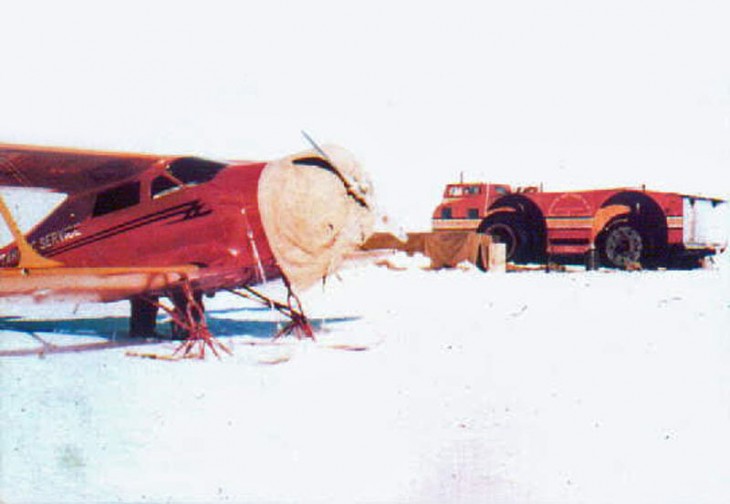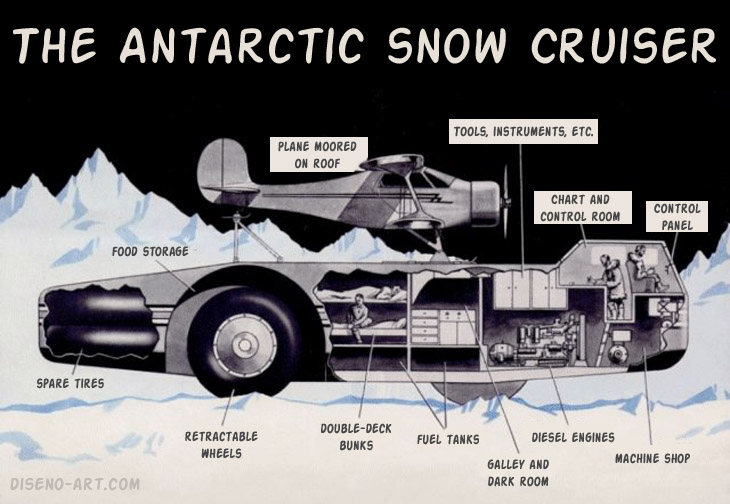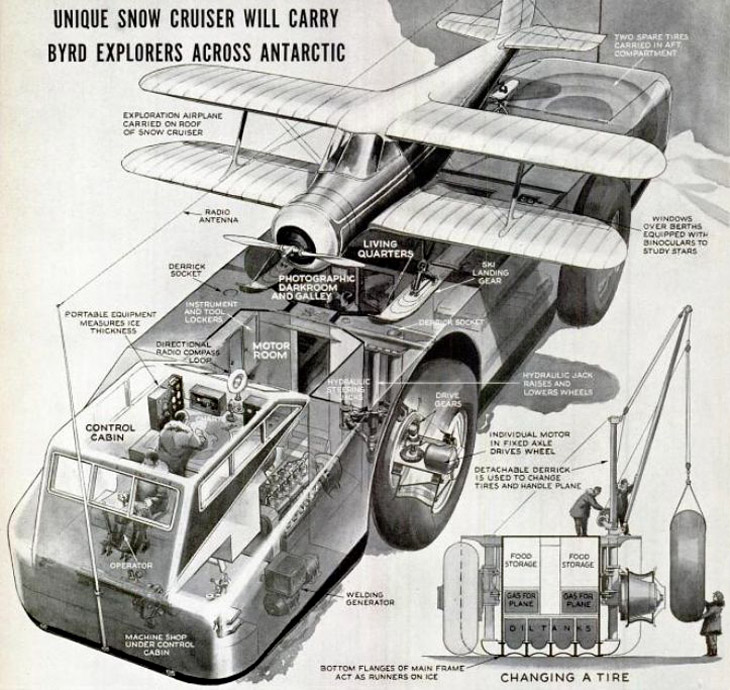Strange Vehicles > Antarctic Snow Cruiser

The Antarctic Snow Cruiser (a.k.a. "Penguin 1") was a hugely ambitious one-of-a-kind vehicle developed in the late 1930s. It was built under the direction of American scientist and arctic explorer Thomas Poulter, and was intended to act as a giant self-contained transport vehicle, research station and accommodation unit for a 1939 Antarctic expedition led by Rear Admiral Richard Byrd, Jr.
Blueprints for the Antarctic Snow Cruiser were shown to officials in Washington, D.C. in the spring of 1939. The Research Foundation of the Armour Institute of Technology would foot the bill for the construction, and then lend the vehicle to the United States Antarctic Service. Amazingly it only took 11 weeks to build, lumbering out of the warehouse of the Pullman Company in Gary, Indiana on October 24, 1939. It then began a 1,000 mile journey to the Boston Army Wharf. During this trip, the Antarctic Snow Cruiser famously drove off a small bridge on the Lincoln Highway due to a damaged steering system. It took three days to get it out, but thankfully no major damage was sustained. After arriving at its destination, the Antarctic Snow Cruiser was loaded aboard the vessel the North Star which set sail headed for Antarctica on November 15 1939.
Antarctic Mission
The North Star and its unusual cargo arrived at Little America in the Bay of Whales, Antarctica in early January 1940. Then the problems really started. Unloading it was the first hurdle. A ramp was built from timber so it could be driven off the ship, but one of the wheels broke through and the Snow Cruiser became stuck for a moment. With Poulter behind the wheel, and the engines at full throttle it managed to break free and continue onto the snow.

This is where the real disappointment came. Instead of effortlessly cruising over the snow and ice, the Antarctic Snow Cruiser sat there spinning its wheels. The treadless tires were practically useless! With chains attached it was slightly better. But bizarrely the crew found the best solution was to drive the vehicle in reverse. The longest excursion undertaken by the Antarctic Snow Cruiser was 92 miles. It was driven entirely in reverse.
On 24 January 1940, Poulter left Antarctica and returned to the US, leaving F. Alton Wade and a partial crew behind to continue using the vehicle for accommodation and scientific research. The scientists conducted seismologic experiments, cosmic-ray measurements, and ice core sampling while living in the vehicle which the had covered with timber and snow for better insulation.
However as the US became more involved in the ongoing Second World War, funding for Antarctic research dwindled, and the Snow Cruiser was abandoned where it stood in early 1941.

Specifications
Length: 17.0 metres (55 feet 9 inches
Width: 6.06 meters (19 feet 11 inches)
Height (wheels retracted): 3.7 meters (12 feet)
Height (wheels extended): 4.9 meters (16 feet)
Fully loaded Weight: 34,000 kg (75,000 lb)
Range: 5,000 miles (8,000 km)
Maximum Speed: 48 km/hour (30 miles/hour)
Self-Sufficiency: 1 year under the most extreme conditions
Fuel Capacity: 9,463 liters (2,500 US gallons) stored under the floor
Additional Fuel Capacity: 3,785 liters (1,000 US gallons) stored on the roof, to be used by the plane
Crew Size: 5 people
Estimated Final Cost: $300,000
Cabin Compartments: control cabin, machine shop, combination kitchen/darkroom, storage for fuel, food, two spare tires
Rediscovery
In the late 1940s, an expedition team found the Antarctic Snow Cruiser where it had been left, and despite a thick layer of snow it was undamaged. The team reported that only air in the tires and a basic servicing would have had it up and running.
The vehicle was again rediscovered in 1958, this time by an international expedition. They uncovered it using a bulldozer and again found the vehicle to be in the exact condition it had been left in.
Later expeditions found no trace of the vehicle. Several theories have been put forward regarding the vehicles fate.
1. It's just hidden under the snow and ice.
2. As the Antarctic ice shelf is continually moving and breaking up, the vehicle has been deposited somewhere at the bottom of the Southern Ocean.
3. The Soviets went and got it - least likely scenario, but most amusing.

--
